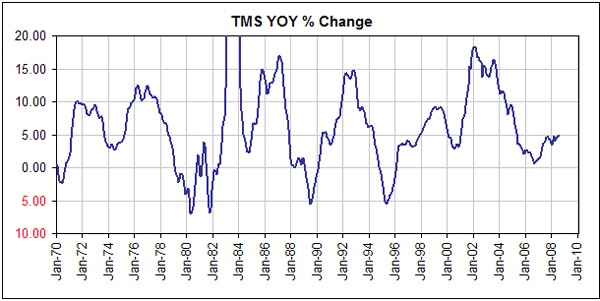Gold and the Money Supply
Steve Saville
email: sas888_hk@yahoo.com
Aug 19, 2008
Paul van Eeden calculates a "Theoretical Gold Price" based on the difference between US$ inflation and gold inflation (the difference between the rate of growth in US dollar supply and the rate of growth in gold supply). Over very long periods (decades) his theoretical gold price approximates the actual gold price, although at any time the actual gold price will often be well above or well below the theoretical price. For example, gold peaked in January-1980 at more than four times its "theoretical price" at the time.
According to Paul's calculations the "theoretical gold price" is presently around $750/ounce, suggesting that gold was significantly over-valued near its recent highs and is now approaching fair value. For further details, refer to Al Korelin's two-part interview with Paul van Eeden at http://www.kereport.com/audio/0802-02.mp3 and http://www.kereport.com/audio/0802-03.mp3.
Over the long term there should be a relationship between the US$ gold price and the difference between the rates of dollar and gold supply growth. However, using this relationship to determine a correct value, or "theoretical price", for gold is fraught with pitfalls because assumptions must be made that aren't necessarily correct. Two of the most important of these assumptions involve the choice of money-supply measure and the 'guesstimate' of the aboveground gold supply. For example, there is considerable disagreement over the best way to measure the total supply of money, and in our opinion there is no way of coming up with a high-confidence estimate of the amount of available-for-sale gold in the world.
Due to the questionable assumptions involved, we are skeptical that a specific number can be calculated that accurately represents gold's underlying value. But as stated above, we do agree that there should be a long-term relationship between the US$ gold price and the difference between the inflation rates of the dollar and gold. Moreover, because gold's inflation rate is almost constant (the aboveground supply of gold increases by 1.5%-2.0% every year) the important variable in this relationship is the rate of change in US$ supply. As evidenced by the following chart of the year-over-year (YOY) growth rate of "True Money Supply" (refer to http://www.mises.org/content/nofed/chart.aspx?series=TMS for the definition of TMS), the dollar's inflation rate tends to undergo large swings.

When we compare the TMS trends with gold price trends we see a loose relationship between the two that can be described as follows: Major turning points in the TMS YOY growth rate LEAD major turning points in the gold price by 2.0-4.5 years. To be more specific, peaks in the TMS growth rate tend to precede peaks in the gold price and troughs in the TMS growth rate tend to precede troughs in the gold price by anywhere from 2.0 to 4.5 years.
Due to the long and variable leads/lags involved, it is difficult to apply the above-described relationship to real-time investment decisions. However, it's worth noting that the most recent trough in the TMS growth rate occurred in October of 2006. The money-supply backdrop has therefore been bearish for gold over the past 2 years and could remain bearish for up to another 2.5 years.
Other factors -- primarily, the credit crisis -- obviously overrode the bearish money supply backdrop between August of 2007 and March of 2008, and could do so again over the months ahead. In fact, our expectation has been that other factors, most notably the bear market in the financial sector, would propel the gold price to much higher levels during the second half of 2008 and/or the first half of 2009. This is still our preferred scenario, but the recent price action could mean that the bearish money-supply backdrop has begun to dominate. In our opinion, the money-supply situation is the only valid bearish argument that can be made about gold's intermediate-term outlook.
There are two additional points we'd like to make, the first being that over normal investment timeframes the general expectation regarding what will happen to money in the future is vastly more important to the gold price than what has happened to money in the past. This is why there are such long and variable leads/lags between money-supply and gold-price trends and why gold traded at more than 4-times its so-called "theoretical value" in January of 1980. To put it another way, there is no limit to how far gold can trade above a value determined solely by past money-supply growth because gold's price today is largely determined by what the market expects to happen to money in the future.
The final point is that even if the bearish money-supply situation overrides other factors over the coming year, the end of the currently-occurring panic sell-off in the gold market will almost certainly be followed by a rebound that retraces a large chunk of the decline.
Steve Saville
 email: sas888_hk@yahoo.com email: sas888_hk@yahoo.com
Hong Kong Regular financial market forecasts and analyses are provided at our web site:
http://www.speculative-investor.com/new/index.html. We aren't offering a free trial subscription at this time, but free samples of our work (excerpts from our regular commentaries) can be viewed at: http://tsi-blog.com
Copyright ©2002-2019 speculative-investor.com All Rights Reserved. Saville Archives
321gold Ltd

|

